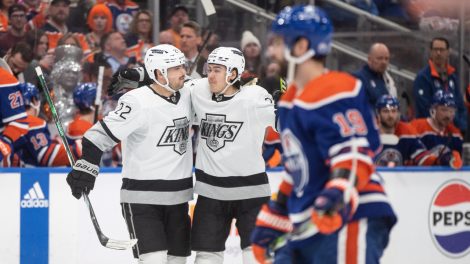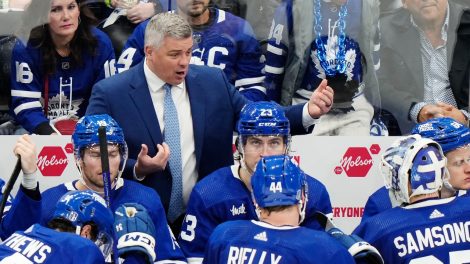I ran into Red Kelly’s daughter in our neighbourhood earlier this week, like I do from time to time. She said her Hall of Fame father had been at Sunnybrook Hospital for a few weeks, but was hopefully going to be moved to a rehabilitation hospital soon. She mentioned that Frank Mahovlich and Dick Duff had visited him the previous day and that had cheered him up. So I was sorry to hear that her cautious optimism wouldn’t be realized — that he died on May 2.
I read the notification while I was glancing at other sports articles and social media, including many references to May 2 being the 52nd anniversary of the last time the Toronto Maple Leafs won the Stanley Cup. It was also the last of an incredible eight Stanley Cups that Red Kelly won in his NHL career.
I was really fortunate to get a job working in the press box at Maple Leafs home games in the 1975-76 season when I was still in high school. My final job of the evening was to deliver official score sheets about 15 minutes after the final buzzer.
One of the three stops on my route was the Leafs coaches’ office, a small, quiet sanctuary away from the bustle of the team dressing room, which was connected to a door on the other side of the office. The door would be opened by the legendary Red Kelly, then the team’s head coach. He always had that same smile and pleasant manner and very little to say as he took the game statistics from me.
There were many cool things about that job for a high-school kid. But to interact with Red Kelly for at least 15 seconds for all 40 Leafs home games (plus playoffs) was among those at the top of my boyhood dream list.
I soon found myself working part-time in the Leafs offices while I attended the University of Toronto. I got to hear many others do the talking for Leonard “Red” Kelly — about what kind of player he was, what kind of coach he was, and most importantly, what kind of person he was. Be it Jim Gregory, King Clancy, Johnny Bower, Roger Neilson, George Armstrong, Gerry McNamara, Punch Imlach or even Harold Ballard… I never heard one negative word about Kelly.
I didn’t find out until recently why Kelly wasn’t a Leaf in the first place. Why was he a Detroit Red Wing when all the great young players from Ontario became property of the Toronto Maple Leafs from their junior days? It turns out that Kelly wasn’t deemed the type of hot young prospect that the Leafs aggressively signed and placed with either St. Michael’s College or the Toronto Marlboros — like a Dave Keon, Frank Mahovlich, Dick Duff or Bob Pulford. Kelly was basically a walk-on, long-shot addition to the St. Michael’s team.
When his skills and persistence became evident, it was a Detroit Red Wings scout who quickly inked Kelly to a contract before the Leafs could see the error of their ways.
[relatedlinks]
From being a walk-on in junior hockey, Kelly graduated and immediately walked on to the Red Wings, something that very few players did without at least one year in one of the many professional minor leagues. It was the Red Wings era of the Big Red Machine, the dominant NHL team for part of a decade. And Kelly was a dominant part of the dominant team.
In almost 12 seasons as a Red Wing, Kelly would be named a First Team All-Star on Defence six times (1951, ’52, ’53, ’54, ’55 and ’57) and would win the Norris Trophy the first year it was awarded in 1954. The Lady Byng Trophy had more prestige back then and Kelly would win it four times as well.
But Kelly was about team-first awards. And the ultimate award was the Stanley Cup. The Red Wings would win four Cups in a period of six years (1950, ’52, ’54 and ’55) with Kelly as one of their stars.
Kelly would form a great friendship with Gordie Howe. So much so that when Howe was set up on a date of sorts with figure skater Barbara Ann Scott when the Hollywood Ice Revue was visiting Detroit, he asked Kelly to tag along. Though nothing came of the set-up date, Kelly met another skater named Andra McLaughlin that night. They were married eight years later and became one of the great love stories off the ice along with their respective great success professionally on the ice.
When Punch Imlach became team GM, he recognized that his young emerging talent was developing into something special (does that sound like the current Leafs at all?). He knew he needed a few final veteran pieces to complete a team that could win a Stanley Cup. In the span of 18 months, Imlach added a veteran goaltender (Johnny Bower), defenceman (Allan Stanley) and toughness at forward (Bert Olmstead). They were all great acquisitions, but Kelly was the cherry on the sundae when he was acquired from Detroit.
Imlach also got Kelly to agree to switch positions. Just imagine that. Think that one through. Kelly had already had a Hall of Fame career in Detroit as a defenceman and now he was being asked to play centre. The Leafs needed a centre he could match up against the top five centres on the other five NHL teams — Kelly was needed to go head to head against the likes of Jean Beliveau, Stan Mikita and Norm Ullman.
Because Kelly was team first, he agreed to do it. And it reaped dividends for the Leafs as a team.
What he helped bring to Detroit, Kelly quickly brought to Toronto — Stanley Cups. The Leafs would win four Cups in a span of seven years.
I learned from his teammates that Kelly was the quiet presence in the dressing room. The clutch player, the dependable player, the unselfish player — the player who understood and did whatever it took to win. Even though he won many NHL awards and was inducted into the Hockey Hall of Fame, he was still valued and appreciated even more by those teammates in the dressing room.
His calm nature showed from time to time when teammates caught him taking a brief cat nap while others were uptight about the pressures of an upcoming game. He also never swore in an era when that was far more the exception than the rule. The word “hang” was as profane as it got for him.
Post playing career, Kelly had three stops as an NHL coach. He spent time with the L.A. Kings and Pittsburgh Penguins before taking his place behind the Leafs’ bench for four years. He was the coach when another group of young Leafs players — including Darryl Sittler, Lanny McDonald, Tiger Williams, Ian Turnbull and Borje Salming — were entering the NHL and evolving into elite players. Though Kelly had a low-key personality, he allowed his Leafs teams to play an exciting, wide-open style of hockey. He let his players exhibit their individual skills and strengths that benefitted those improving Leaf teams. And it was fun to watch.
By the time I started to work full-time for the Leafs, Kelly had left to be replaced by Roger Neilson. For the first number of months, I didn’t have a pad of memo paper with my name on it like others in the office did. So I used up the “From the desk of Red Kelly” pads for almost a year before a pack of Gord Stellick one arrived. I thought that was cool — just as it had been to interact with him briefly post-game for a few seasons.
If I could write one final memo on that paper today I would write something like this:
“Thank you for the great joy you brought to Toronto Maple Leafs fans and to NHL fans everywhere. For playing an unselfish, team-oriented role that resulted in team success. For coaching the Leafs teams of my teen years and making the games fun and entertaining, and making the team better. For the class and dignity you carried yourself with and how kind you were to everyone. You were considered hockey royalty, but you made everyone else feel special.”









